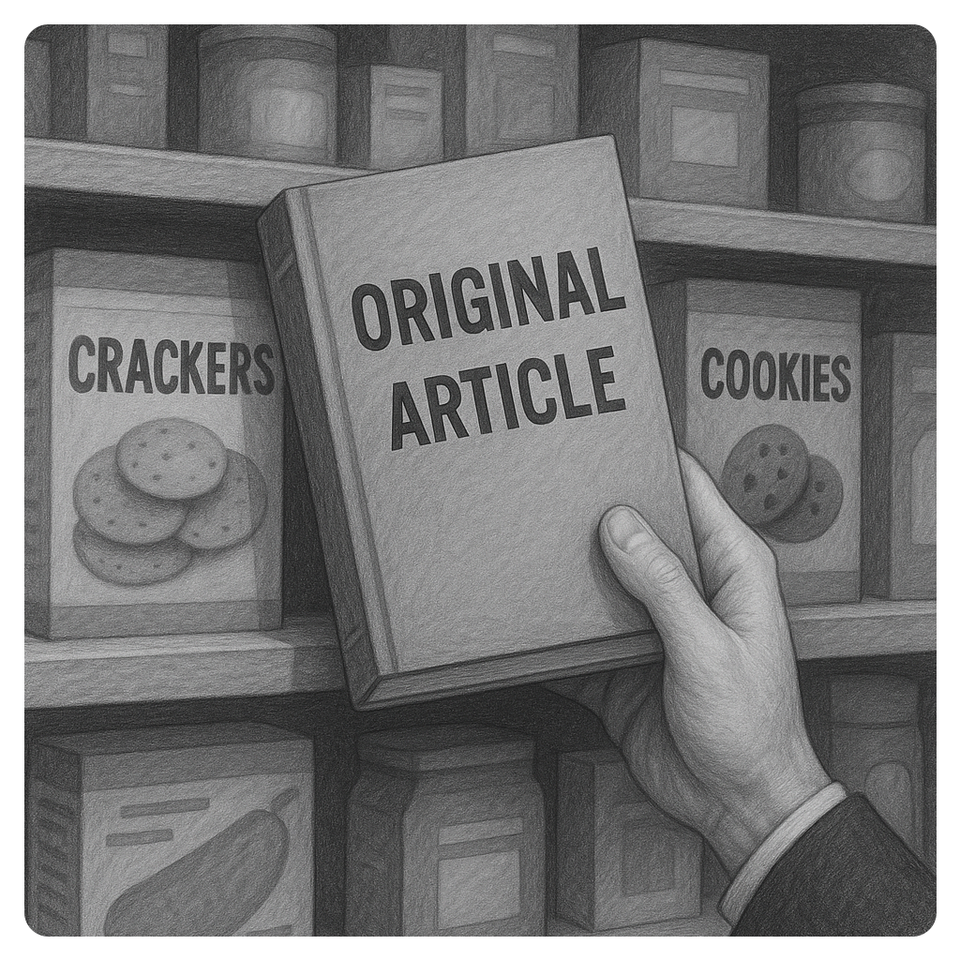The exact moment your content becomes "supermarket noise"

Yesterday, I was researching a client project and had to slog through 23 articles about 'workflow management' in a particular industry. Read some parts, skimmed others. Here's what struck me: I could have written 22 of them with ChatGPT in under 30 minutes.
Same buzzwords, similar structure, same predictability. Generic insights recycled endlessly
And that's when it hit me. If AI could have written your article, it already belongs in the bookmark graveyard. It's already dead.
Shelves that never empty
Picture a supermarket where workers restock every aisle every sixty seconds. Boxes pile six deep, labels blur together, and you leave empty-handed despite spending an hour wandering the aisles.
That's exactly what's happening online right now. Most marketing teams respond to content saturation by cramming in even more boxes (e.g., daily tips, repurposed threads, recycled webinars) because KPIs reward output, not uptake.

More than half of LinkedIn's long-form posts are now AI-generated. Readers scroll past hundreds of headlines before lunch. Algorithms re-blend yesterday's text into today's déjà vu. The shelves of the internet supermarket refill faster than anyone can shop them.
Each extra piece hides the one behind it. Activity climbs, recall plummets.
Saved doesn't mean survived
Pieces usually die after they're saved, not before.
Last month, I watched a marketing director frantically search her saved articles for "that piece about customer retention." Twenty minutes later, she gave up and Googled it instead. The article she'd bookmarked three weeks earlier was buried on page 12 of her saves, invisible and useless.
Your best-performing post from last month will be completely forgotten by Christmas. Not because it was bad. Because it was forgettable.
The lone surviving signal in all this noise? A detail a robot cannot fake.
What AI can't manufacture
I've seen this pattern play out dozens of times now.
- Logistics scars win. A supply-chain engineer once posted the exact SAP error code and the six weird steps that fixed a stranded shipment. Practitioners forwarded that link across Slack within hours.
- Sameness flop. A SaaS firm tripled output with daily "workflow optimisers" - each clone of the last. Traffic flat-lined. Average read time dropped 42 percent. Quantity multiplied obscurity.
And the reason? Large language models predict plausible next words from public text. They can mimic warmth and cadence, but they cannot invent the bruises insiders recognise.
Your brain is wired to spot the difference
There's a reason that the SAP error code spread like wildfire while generic advice gets ignored. When people encounter a stream of similar items, their brain literally flags the lone outlier as important and stores it for later. Your mind treats sameness as junk mail while stamping oddball details for priority processing.

I tested this with a client recently. We published two LinkedIn posts about productivity:
- Post A: "Five ways to optimise your workflow."
- Post B: "The 11:47 PM Slack message that saved my startup."
Post B received 140% more saves and 6x more forwards.
That oddball timestamp? Your brain can't help but flag specific details like that, while generic advice gets dumped into the forgettable pile.
The litmus test before you publish
Before you hit publish, ask yourself three questions:
- Could an LLM plausibly output this paragraph? If yes, dig until the answer flips. Surface the invoice line item, the debug string, and the lived misstep.
- Will a practitioner quote one line aloud tomorrow? If not, embed a brain tattoo that won't fade. A dollar figure, a two-word metaphor, a face-palm moment that makes them nod in recognition.
- Does the piece end on one concrete next step? Action wires ideas into muscle memory. Theory alone evaporates by Tuesday.
How to create content that survives
Delete every sentence that states obvious truths. Lines like "content is noisy" or "attention is scarce" are bland truths that add nothing. Keep only material that proves, extends, or illustrates the big claim. Copy-paste content equals death.
| Keep | Cut |
|---|---|
| A number that shocks | Generic "add value" line |
| An anecdote only a witness could know | Another "content is king" cliché |
Find your unfakeable detail. Write the CIO's exact Slack message when the budget exploded. Describe the specific error code, timestamp, and sensory detail that only you witnessed. Gift readers a fingerprint a machine can't forge.
I call it sharpening without shouting. No clickbait or ALL-CAPS required. Sharpness lives in precision, not volume.
"But I can't share confidential details"
For those in regulated industries thinking, "I can't share client details due to compliance" - you're absolutely right. But specificity doesn't require confidentiality breaches.
Instead of the exact client name, use "the Fortune 500 manufacturer." Instead of the actual error code, describe "the 3-word error message that stumped our dev team for six hours." Find the unfakeable detail within your constraints. There's always something specific you can share without crossing compliance lines.
What actually survives the noise
In an economy of infinite supply and shrinking attention, content endures when it offers three things:
- Un-fakeable specificity (the bruise). Lived experience details prove you have skin in the game. Readers trust skin, not spin.
- A retrieval hook (the tattoo). A sticky phrase, odd metaphor, or single jaw-dropping stat turns the article into mental graffiti the brain can't throw away.
- An executable step (the cash-out). A clear action that converts curiosity into behaviour, giving your insight a foothold in daily work.
Everything else is just louder, longer, prettier supermarket noise
Try this next week
Audit your last three articles. For each one, ask: "Could I have generated this with three ChatGPT prompts?"
If yes, find one detail only you know. The exact error message. The 2 AM realisation. The client's verbatim objection. Rewrite that section with your scar tissue showing.
Then watch which version people actually quote in meetings. What you'll likely find: That one detail will win out and be used verbatim, even if the impressions are lower. While everyone else fights for attention with identical boxes, you'll be the one voice that stands out simply because you sound human.
Because if ChatGPT could have written it, the Save-and-Forget Cemetery already has a plot reserved.